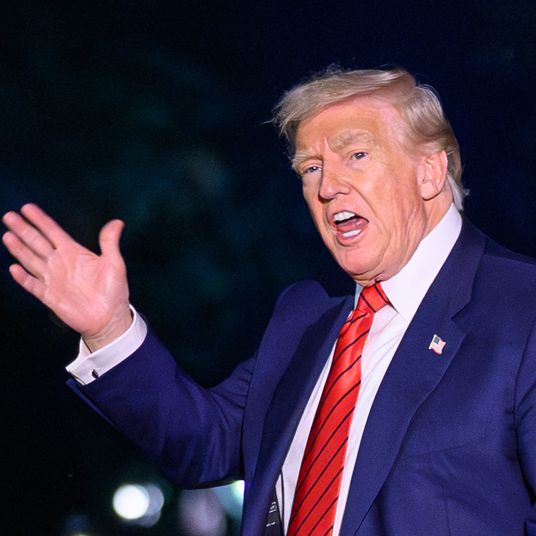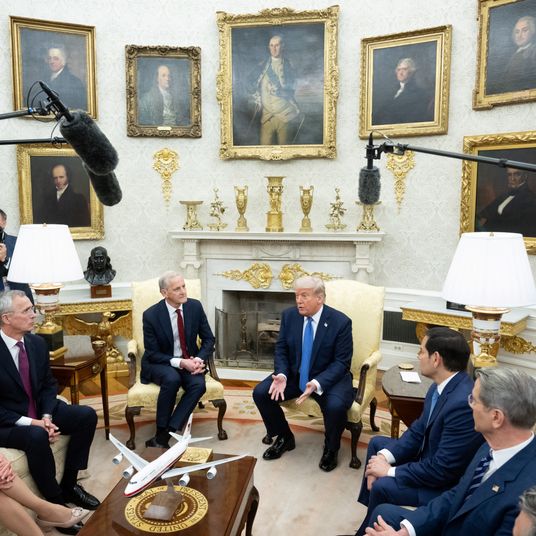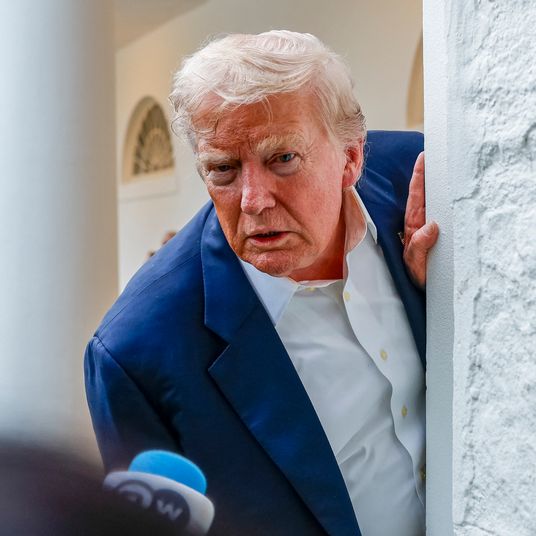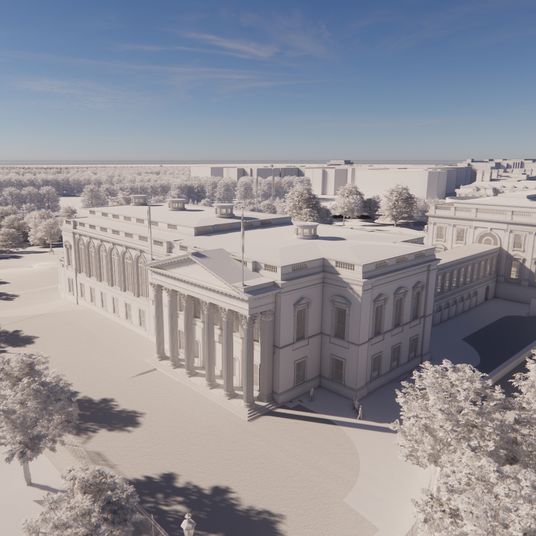Donald Trump has been dancing around the January 6 riot since it happened. He has talked about the insurrection in a way that communicates to his supporters his affinity for the rioters, but without endorsing their actions directly.
Now Trump’s words finally match his music. Asked by Jonathan Karl about protesters in the capitol chanting “Hang Mike Pence,” Trump for the first time explicitly justified the rioters’ desire to lynch his vice-president:
JONATHAN KARL: “Were you worried about him during that siege? Were you worried about his safety?”
TRUMP: “No, I thought he was well-protected, and I had heard that he was in good shape. No. Because I had heard he was in very good shape. But, but, no, I think — “
KARL: “Because you heard those chants — that was terrible. I mean — “
TRUMP: “He could have — well, the people were very angry.”
KARL: “They were saying ‘hang Mike Pence.’”
TRUMP: “Because it’s common sense, Jon. It’s common sense that you’re supposed to protect. How can you — if you know a vote is fraudulent, right? — how can you pass on a fraudulent vote to Congress?
Some of Trump’s supporters are trying to claim he doesn’t mean what he says. But it’s obvious Trump meant exactly what he told Karl, because this is where his rhetoric has been heading all along.
Multiple reports have shown that Trump thrilled to the insurrection as it occurred, refusing for hours to ask his supporters to stop and lashing out at Republicans who expressed concern for their own safety. (“Well, Kevin, I guess these people are more upset about the election than you are,” he scolded the House minority leader on January 6.)
A backlash among Republicans — who briefly entertained the notion of impeaching him — forced Trump to publicly disavow the insurrection. Reading from a script in the Oval Office on January 13, Trump said, “Like all of you, I was shocked and saddened by the calamity at the Capitol last week … I want to be very clear: I unequivocally condemn the violence that we saw last week. Violence and vandalism have absolutely no place in our country.”
You could detect a hint of what was to come when Trump changed the subject away from that riot to other bad riots carried out by his enemies. “We have seen too many riots, too many mobs, too many acts of intimidation and destruction … Whether you are on the right or on the left, a Democrat or a Republican, there is never a justification for violence.” He turned to a denunciation of “the efforts to cancel, censor, and blacklist our fellow citizens.”
After Republicans abandoned impeachment, Trump began to downplay the riot, which was no longer a “calamity” but a minor act of trespassing. “It was zero threat. Right from the start, it was zero threat,” he told Fox News host Laura Ingraham in March. “Look, they went in — they shouldn’t have done it — some of them went in, and they’re hugging and kissing the police and the guards, you know? They had great relationships. A lot of the people were waved in and then they walked in, and they walked out.”
Trump’s main argument at this time was his customary whataboutism. In May, he was railing at Democrats for investigating January 6 instead of the George Floyd protests:
Republicans in the House and Senate should not approve the Democrat trap of the January 6 Commission. It is just more partisan unfairness and unless the murders, riots, and fire bombings in Portland, Minneapolis, Seattle, Chicago, and New York are also going to be studied, this discussion should be ended immediately.
“Instead of doing a Forensic Audit, they want to investigate the Patriots who have fought for the truth and who are exposing a very possibly Rigged Election,” Trump wrote in June. “Do people see the Radical Left prosecutors, and what they are trying to do to 75M+++ Voters and Patriots, for what it is?” he railed a week later.
Whether or not this was a conscious strategy, Trump was drawing a tighter connection between the riot and the election. Trump’s demand over the summer was that the people investigating the riot acknowledge that the rioters correctly believed Trump’s election had been stolen (“Will Nancy and her Committee study the massive Voter Fraud that took place during the 2020 Presidential Election, particularly in swing states, that was the reason hundreds of thousands of people came pouring into Washington and, therefore, must be a big factor in the final Committee Report?”)
Also in July, Trump began to emphasize the wrongful suffering of the rioters. The phrase “Who shot Ashley Babbit?” — a reference to the rioter who was shot trying to break through one of the last lines of defense between the rioters and the hiding members of Congress – began to creep into his rhetoric. The prosecution of the rioters was a Justice Department witch hunt against his supporters: “Our hearts and minds are with the people being persecuted so unfairly relating to the January 6th protest concerning the Rigged Presidential Election.”
One of Trump’s signature rhetorical moves is to take phrases used against him or his supporters and turn them against his critics. “Fake news” originated as a description of literally imaginary news stories written as a hoax, but Trump turned it into a conservative label for any news story that painted him in a bad light. Likewise, he instructed his supporters that “insurrection” meant the election, not the January 6 riot hoping to overturn it.
Here is a sample of how Trump was framing the issue as of last month:
The Unselect Committee of partisan Democrats, and two very weak and pathetic RINOs, should come to the conclusion after spending many millions of dollars, that the real insurrection happened on November 3rd, the Presidential Election, not on January 6th — which was a day of protesting the Fake Election results.
He had crept right up to the edge of endorsing the riot. It only took the slightest evolution in his rhetoric to slip over the line into glorifying the mob’s violent intentions. Trump’s explanation is remarkably clear. Why were the people angry enough to want to hang Pence? Because it’s common sense, Jon. It’s common sense that you’re supposed to protect. How can you — if you know a vote is fraudulent, right? — how can you pass on a fraudulent vote to Congress?
For a famously disordered mind, that is a perfectly logical inference. If a landslide election result had been stolen, and if the vice-president refused to take the legal steps available to him to rectify the error, why would the threat of lethal force be disproportionate?
At the literal level, Trump’s line on the riot has transformed by 180 degrees, from denouncing it as a “calamity” to praising it as “common sense.” But the truth is that his supporters have understood that Trump supported the insurrection all along because they took him seriously, not literally.
If Trump runs again, he will either win fairly or claim he was cheated. And if the latter occurs, his supporters will know exactly what he wants them to do.
























